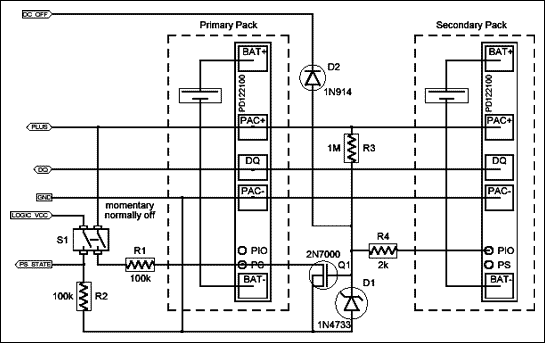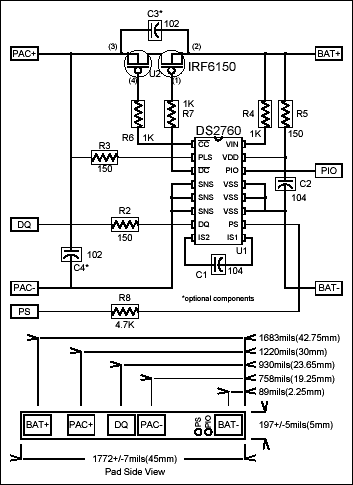

多种电池组应用的DS2760或DS2761-Multiple
电源新闻
20人已加入
描述
Abstract: This application note presents to the reader a recommended reference circuit design that supports monitoring and control of power delivery to a multiple battery system using the Dallas Semiconductor DS2760 or DS2761 battery monitor and protector. It explains the proper circuit layout and DS2760/61 configuration to enable the switching of multiple battery sources without power loss contention. Additionally all needed external signals and connections are presented and described in detail.

Multi-Pack Configuration

PD122100 CSP Demo Board
打开APP阅读更多精彩内容
Introduction
One of the advantages of the DS27xx series of integrated Li-Ion protection products, and in particular the DS2760, is the capability to monitor and control battery power delivery within multi-battery systems. This application note will demonstrate an implementation of a circuit that supports the switching of multiple battery sources without power loss contention. It is recommended that the reader become familiar with the DS2760 datasheet, particularly the SWAP, PMOD, PS, and PIO functions, before reading this document.
Multi-Pack Configuration
General System Description
It is assumed that the end equipment may be supplied power from a primary pack, a secondary pack, or a DC source. The power switch function of the primary pack is the locus of all used initiated power activity. In the case of a battery powered environment, the momentary closure of S1, the power switch, will wake the primary pack, supplying power to an initially powered-down system. If the system is presently powered, the depression of the power switch has no consequence and is simply reported to the system as an asynchronous user event. In an active system, battery power is switched via issuance of a 1-Wire interface sequence (set DE = 0). Finally, the hot extraction of the active power source, other than the primary pack, will force the primary pack onto the power bus in a manner similar to that of a power switch closure.Detailed Description
The circuit above utilizes the PD122100 demo board as the basis of a standard implementation of a battery management circuit. The PD122100 schematic is provided for reference on the last page of this document. This product provides power control of the individual batteries as well as features outside the scope of this applications note (see DS2760 High Precision Li-Ion Battery Monitor data sheet). The DS2760s in both the primary and secondary packs are programmed to enable the SWAP command (STATUS:SWEN = 1) and SLEEP MODE (STATUS:PMOD = 1). The SWAP command, issued through the common 1-Wire data interface DQ, is the primary means of switching battery power under host control. The DC source gaining control of the common switched power bus, PLUS, is conditional on the power state of the equipment. If the system is off (PLUS low) and DC is applied, PLUS will be driven by DC. In the case where the system is battery powered and DC is applied, the system will grant DC control of power by the issuance of a SWAP command to a non-existent device, disengaging all packs, followed immediately by the gating of DC onto PLUS. Though the details are system-dependent, the DC source control circuit must power the equipment if PLUS was low prior to the DC insertion. Further DC must be controlled by a switch to avoid contention when PLUS is battery powered. The signal DC_OFF is provided to avoid a PLUS contention caused by a power switch (S1) request and facilitates uninteruptable power if DC is removed during system operation. In this implementation, DC_OFF will be driven to GND on DC present and high-Z in DC's absence. The pack labeled primary is designated to be operable in the case of a hot extraction of either the DC source or the secondary battery. In the case when a battery only system is powered off, the primary battery will initiate power through the detection of a closure on switch S1. Prior to SWAPing from the primary to secondary pack, the system will set the PIO bit in the DS2760of the secondary battery. This has the same effect for the secondary pack as DC_OFF low did for DC in that both the S1 induced power contention and the maintenance of un-interruptible power issues are addressed.Summary
By the judicious use of the SWAP, PMOD, PS, and PIO functions of the DS2760, the complexities of multi-pack power switching systems are simply addressed. Hot extraction recovery, problematic in any system, is addressed by the channeling of the appropriate removal detection signals into the power switch control input (PS pin) of a predestinated battery pack.
PD122100 CSP Demo Board
声明:本文内容及配图由入驻作者撰写或者入驻合作网站授权转载。文章观点仅代表作者本人,不代表电子发烧友网立场。文章及其配图仅供工程师学习之用,如有内容侵权或者其他违规问题,请联系本站处理。
举报投诉
-
测试和校准DS2760锂离子电池监测和保护器电路2023-03-09 1407
-
DS2760 1-Wire高精度锂离子电池监视和保护IC在微控制器环境中的接口2023-03-01 1845
-
DS2760BE PMIC - 电池管理2023-01-29 35
-
DS2760或DS2761电池监测器在多节电池中的应用2023-01-11 2153
-
DS276x产品比较-DS276x Product Comp2009-04-30 1083
-
接口的DS2760 1线高精度锂离子电池监控和保护IC在单片2009-04-29 1131
-
Interfacing the DS2760 1-Wire2009-04-23 1486
全部0条评论

快来发表一下你的评论吧 !

